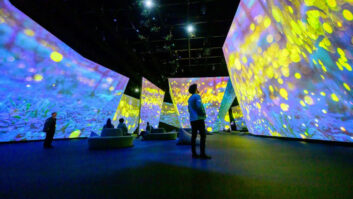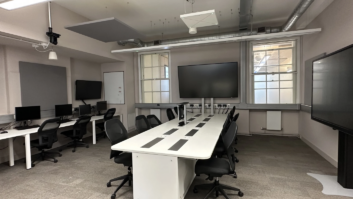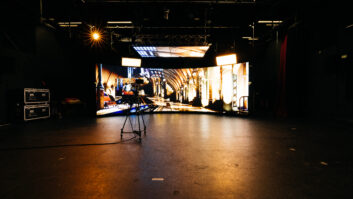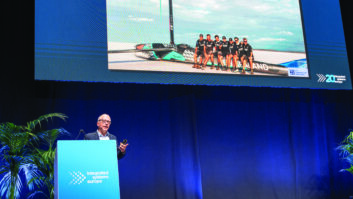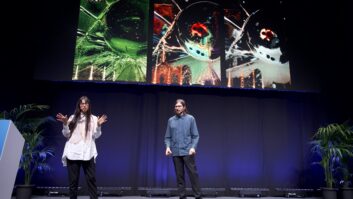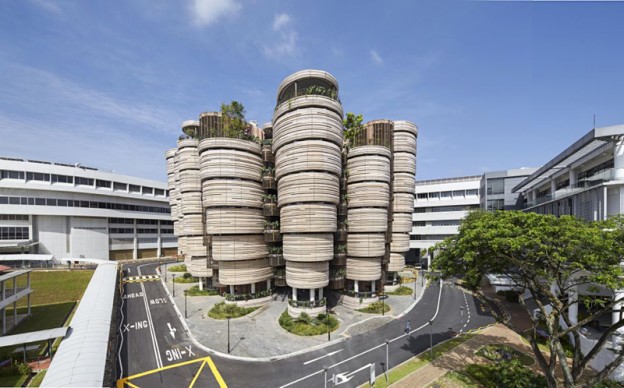
Nanyang Technological University (NTU) has unveiled Singapore’s latest architectural icon, which will be open for use by students from the new academic year later this month.
An advanced educational hub by top UK designer Thomas Heatherwick, the man behind the London Olympic Cauldron, it will support NTU’s ambitions in pushing the frontiers of innovation in learning and sustainable building design.
Its 56 latest-generation smart classrooms are fully equipped for collaborative learning and student interaction, which is the hallmark of the university’s blueprint for preparing students with skills needed in the 21st century workplace.
The futuristic building will also be a hive of student initiatives and programmes that will foster the spirit of entrepreneurship, innovation and social awareness among students. An example of how a student could typically spend his or her day at the new learning hub is Nicholas Lim’s story.
NTU engineering freshman Nicholas Lim is raring to go for his tutorial at the learning hub, where he’s making a presentation on how the study of astronomy has transformed in the last century. Before his class, he stops by the Library Outpost to retrieve his reserved book using an automated book dispensing machine that simply scans his matriculation card. He then goes for a quick one-to-one coaching session at the Communication Cube to polish his presentation skills before his tutorial.
During his class, he uses his handheld tablet to take an individual quiz based on the previously assigned readings. He then discusses his own answers on the quiz with his classmates, and his professor helps to clarify their ideas. After his class, Nicholas heads off for lunch at the student-run cafe downstairs with his friends, before joining a film screening also attended by his peers from the arts and business schools.
NTU Professor Kam Chan Hin, senior associate provost (undergraduate education) says: “The new learning hub offers one of the world’s best learning environments for students of the 21st century. It provides an exciting mix of learning, community and recreational spaces for NTU students, professors and researchers from various disciplines to gather and interact. By bringing people and their ideas together, NTU can spark future innovations and new knowledge that increasingly happen at the intersection of disciplines.”
New home for learning innovations and student enterprise
The eight-storey building is envisioned to be a place where students might meet their future business partner or conceive an amazing idea with a university mate. Heatherwick Studio was appointed to design the building following an international competition for best design concept in 2011.
Founder and Principal Thomas Heatherwick, Heatherwick Studio says: “Heatherwick Studio’s first major new building in Asia has offered us an extraordinary opportunity to rethink the traditional university building. In this information age, the most important commodity on a campus is social space to meet and learn from each other. The learning hub is a collection of towers surrounding a central space that brings everyone together, interspersed with nooks, balconies and gardens for informal collaborative learning. We are honoured to have had the chance to work with NTU, a forward-thinking and ambitious academic institution to realise such an unusual project.”
The learning hub houses 56 smart classrooms that will take higher education in Singapore to new heights. Each classroom comes complete with flexible clustered seating for small group discussions, multiple LCD screens and wireless communication tools.
The new classrooms support the ‘flipped classroom’ pedagogy that NTU has introduced, where knowledge transfer from teacher to students takes place before class through various online materials which students can access in their own time. Class time is then better utilised as students actively engage their professors and classmates in discussions and debate, instead of being passive recipients of information. The clustered seating is designed for students to discuss their ideas in small groups, before sharing and presenting their ideas with the rest of the class.
Associate professor Kwok Kian Woon, associate provost (Student Life) at NTU says: “The building’s atrium will be a focal point for expanding the range of community-based activities and initiating new collaborative projects among students. This will not only deepen their learning beyond the curriculum, but also enable them to develop important life skills such as leadership and intercultural competence.”
Students will take the lead in the food and beverage outlet on the ground floor. By the start of the next academic year in August, a student-owned social enterprise will run a café, which will serve healthy food at affordable prices. There will also be regular activities throughout the academic year, for example talks, workshops, hackathons, debates, film screenings, and performances. Outside of tutorial hours, the classrooms and auditorium will be available for booking by student groups.
Key features of the learning hub
As part of Heatherwick’s design, the walls of the inner corridor and staircases are embedded with 700 specially commissioned drawings from illustrator Sara Fanelli which are cast into the concrete. Designed to be ambiguous thought triggers to spark students’ imagination, the drawings take reference from diverse disciplines, ranging from science and technology to art and literature.
The building will also house a Library Outpost offering a broad-based Discovery Collection that comprises a treasure trove of 11,000 video titles and 1,200 books that will eventually grow to about 5,000.
The collection aims to widen students’ horizons beyond their formal studies. One interesting section is the collection named Books Your Professor Reads which is built from requests to professors to nominate their favourite works.
With Wi-Fi available throughout the building, users will also be able to stream other video and audio resources and educational materials from the Outpost to their mobile devices.
A new facility that will be implemented at the Library Outpost is the Automatic Reserves Machine, an automated book dispensing machine. Located just outside the Outpost, students can check out and check in reserved books on their own with this robotic system anytime.
A new Communication Cube run by NTU’s Language and Communication Centre will also be housed at the learning hub. At the Comm Cube, students will have designated coaches, who are senior undergraduates and postgraduate students, giving them one-to-one personal advice and coaching in communication.
Professor Kingsley Bolton, head of the centre says: “The Centre works on the tested principle that students often learn more effectively from their peers than from classroom teachers. In the case of language teaching, this is a principle that has been proven to work at leading universities throughout the world, such as Brown University, Harvard, MIT, and Stanford University.”
The Communication Cube is open to all NTU students and is expected to assist about 1,000 undergraduates and postgraduate students each semester.
21st Century model for innovative green design and sustainability
NTU is known for sustainability, not just in research but also in its infrastructural developments. In 2013, the learning hub received the Green Mark Platinum Award from the Building and Construction Authority (BCA), Singapore’s national benchmark for the design, construction and operation of high performance green buildings.
One of the building’s inventive green features is its unique ventilation system as a more sustainable alternative to conventional air conditioning. No fans are needed for air distribution. In addition, the openings between pods allow for natural ventilation to the atrium, corridors, staircases, and lift lobby.
In line with NTU’s garden campus, the learning hub incorporates a generous amount of natural foliage in its design. Internal vertical greenery and rooftop terraces enhance the garden experience. The greenery also reduces solar glare and natural heat gain, diminishing reliance on artificial cooling devices, while providing reprieve from the tropical heat. The building’s inverted shape enables the upper floors to shade the lower levels, further reducing exposure to solar heat.
Other energy-saving features include energy-efficient light and motion sensors in classrooms, toilets and staircases that keep lighting usage flexible.
The eco-friendly building represents another feather in the cap for NTU, which is already a global leader in sustainability, having garnered more than $1.2 billion in competitive research funding in this area.
If you would like to know more, head over to the Nanyang Technological University website.
Enjoying this content? Sign up for free today to receive the latest opinions, interviews, resources and news from Tech&Learning UK directly to your inbox.

